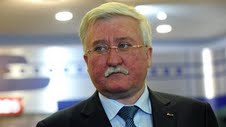Former Almaz-Antey General Director Igor Ashurbeyli gave RIA Novosti a long interview published on Monday. Ashurbeyli was replaced at Almaz-Antey in early 2011, and he’s now a co-chair of the “Extradepartmental Expert Council on Aerospace Defense.”
He’s an accessible figure, having had extended sessions with the media in 2010 and 2009. And his view of things has been pretty consistent.
This most recent Ashurbeyli interview spawned a number of sound bites saying that the former lead designer (among other things):
- called for establishing an overarching VKO industrial concern;
- offered the S-500 for European missile defense; and
- said S-300 production has ended.
He actually had a lot more to say that might be worth a look.
Asked about Moscow’s anti-missile defense, Ashurbeyli replied that the service life of some Russian strategic interceptor missiles expired, while others [53T6 or Gazelle missiles] had their nuclear warheads removed per the decision of former President Yeltsin.
Then Ashurbeyli gets to his point — the need for a new anti-missile defense (PRO) led to work on the mobile S-500 system. Under the contract, it’s supposed to be accepted into the arsenal in 2015. A schematic draft is complete, and technical design is being conducted.
On air defense, he says the S-300 and S-400 cover Moscow, but the service life of S-300PS systems will expire in the next year or two, and the new Vityaz system won’t be ready to take its place in the PVO network.
Ashurbeyli adds that Vityaz is expected in 2014-2015, but delays are possible due to problems with the new missile.
But, insists the former Almaz-Antey chief, there have never been any technical problem with the long-range missile for the S-400. He says the problems have involved financing, preparing prototypes, and targets. More targets and an updated target complex were needed. And he foresees possibly the same problems with Vityaz testing.
Ashurbeyli tells his interviewer Vityaz, unlike the S-400, has just one base missile. It will cover the same missions as the S-300PS and S-300PM. The latter were last manufactured in 1994, and several dozen of the “freshest” will still have life for the next 7-10 years. Most were updated to the Favorit (S-300PMU2) level but they aren’t new. So, Ashurbeyli concludes, Russia needs to produce enough Vityaz to replace fully its S-300PS and S-300PM inventory.
The interviewer says relatively less has been written about Morfey. Ashurbeyli obliges. Morfey, he says, is a super short-range system and part of Russia’s echeloned defense. While Vityaz is a medium-range system, and Pantsir and Tor are short-range weapons, Morfey is super short-range. If developed as envisioned, Morfey will be unique. It will have an omnidirectional cupola-type radar instead of a rotating one.
In sum, Ashurbeyli believes Morfey, Vityaz, S-400, and S-500 will be sufficient for the ground-based component of VKO for 20-25 years. The tasks for Morfey and Vityaz were set in 2007 when the VPK decided to develop a single fifth generation surface-to-air PVO-PRO system. The more complex S-500, he notes, will be longer in development.
More later.

